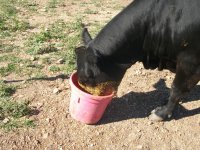You are using an out of date browser. It may not display this or other websites correctly.
You should upgrade or use an alternative browser.
You should upgrade or use an alternative browser.
Distillers Grains
- Thread starter CBowlin
- Start date

Help Support Steer Planet:
firesweepranch
Well-known member
Distillers Grains are a byproduct of the distillation process. There are two main sources of these grains. The traditional sources were from brewers (beer) an more recently, ethanol plants are a growing source. It is created in distilleries by drying the mash.
How much to feed depends on who or what you are feeding. We give all our cows that calve DDG's for about two weeks after calving, around 10 pounds wet (it has a small particle size, so blows away easily. We add water to it when we feed it, make it like a mash, and the cows are less likely to spill it and eat it like candy). I feel like our cows come into their milk better when we do this. Might be crazy, but we do not calve a bunch of cows so for us it works. Especially for our first time calvers, and that way they come up so we can check them and the calf visually to make sure all looks OK. If we are showing a pair, the cow will stay on the DDG to help keep her weight up. It is cheaper and fattens better than a show grain.
Just what we do. And it works. Although recently the price has really gone up (but the price of ALL grain has gone up!). Here is one of our show cows enjoying her DDG's
How much to feed depends on who or what you are feeding. We give all our cows that calve DDG's for about two weeks after calving, around 10 pounds wet (it has a small particle size, so blows away easily. We add water to it when we feed it, make it like a mash, and the cows are less likely to spill it and eat it like candy). I feel like our cows come into their milk better when we do this. Might be crazy, but we do not calve a bunch of cows so for us it works. Especially for our first time calvers, and that way they come up so we can check them and the calf visually to make sure all looks OK. If we are showing a pair, the cow will stay on the DDG to help keep her weight up. It is cheaper and fattens better than a show grain.
Just what we do. And it works. Although recently the price has really gone up (but the price of ALL grain has gone up!). Here is one of our show cows enjoying her DDG's
Attachments
SeannyT
Well-known member
It really depends on why your feeding it: as an energy source or as a protein source. Producers are feeding it for both reasons. If for an energy source, I think the optimal level has been determined anywhere from 10-50% of the diet on a dry matter basis. Its a great substitute, but consistency of batches is nearly impossible. Due to different ethanol extraction techniques, and the high heat used, almost no two batches of DDGS are the same nutrient-wise. A good source of fat and protein though, as ssr stated. It is also comparable to the whole grains in terms of energy content.
nate53
Well-known member
Has anyone used the wet distillers or the syrup and if so how have you fed it, most recommendations have limits on per head per day basis. I heard the wet distillers don't keep in warmer weather but does in colder weather? The syrup comes out really hot (180 degrees F?) and liquidy but as it cools becomes thick,
Dry distillers, Most expensive but stores better and is easier to handle than others
Wet distillers,
Syrup, least expensive
Does anyone have a link to a university study on the different ethanol products and how they are fed and at what rates (there has to be some out there)?
Thanks for any info
Dry distillers, Most expensive but stores better and is easier to handle than others
Wet distillers,
Syrup, least expensive
Does anyone have a link to a university study on the different ethanol products and how they are fed and at what rates (there has to be some out there)?
Thanks for any info
SeannyT
Well-known member
I am doing a paper on inclusion of ddgs in beef cattle diets at the moment, and here are a few papers I have read through. Most data has been done on feeder and finisher calves, but some work with cow/calf operations.
http://www.animal-science.org/content/early/2007/12/21/jas.2007-0550.full.pdf
http://pubs.aic.ca/doi/pdf/10.4141/CJAS08046
http://www.transportation.anl.gov/pdfs/AF/527.pdf (page 9)
http://www.animal-science.org/content/early/2007/12/21/jas.2007-0550.full.pdf
http://pubs.aic.ca/doi/pdf/10.4141/CJAS08046
http://www.transportation.anl.gov/pdfs/AF/527.pdf (page 9)
We have been feeding syrup for over a year now. It comes as a luquid and hot. We buy it by the semi tank load and into a 10,000 gal tank. We put it into wheel lick tanks that you can buy from most mfa. Cows lick wheel round and round. Its like candy to them. We feed it hard during the winter as a supplement. Syrup is high in energy not necessarily protein. We feel the cows keep their condition through the winter and milk well after calving. THey slick up nicely. Syrup is becoming more and more in demand and somewhat more expensive. The downfalls of feeding is it is messy. You gotta have pump, tanks, hoses. Also different plants have different syrup consistency. Some watery some thick. Hope this helps.
